Review by a blown away James Bacon
Fantastique, phénoménal, magnifique, mais c’est aussi la plus grande exposition de bandes dessinées de tous les temps!

With Comics on Every Floor, the Centre Pompidou in Paris sets down an incredible challenge to all cultural centres, galleries, and museums worldwide with its exhibition, Comics 1964 – 2024. This is how to celebrate comics!
Offering a fabulous selection of work spanning six floors, by offering so many key works, in such huge number and breath of art, exhibited with considerable appreciation and sharing of the understanding of comics, they have thrown the gauntlet down, pushing hard to present one of the greatest comic art exhibitions of our time.
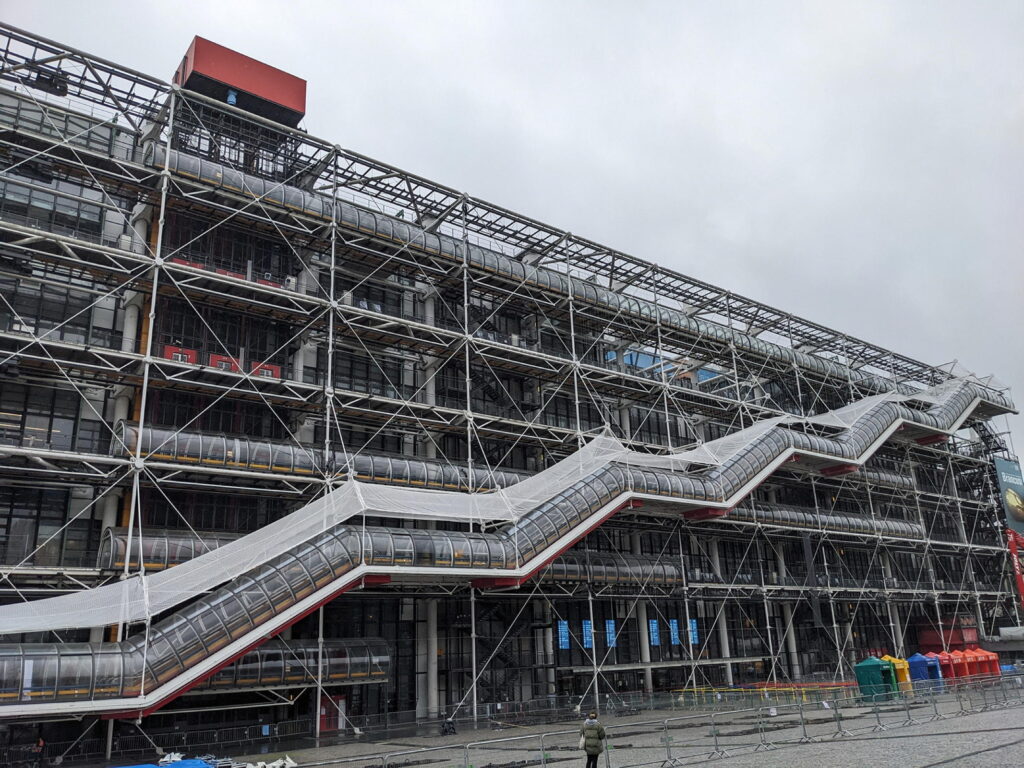
The Pompidou Centre is a huge building, spanning six floors, with a footprint of 180m by 110m – an incredible artistic and cultural centre. I had not truly appreciated how large it was, and as one comes up the series of external escalators in the famous glass tubes outside the building, with all the utilities exposed, incredible views of Paris become visible. This building is vast. I remind myself not to get too excited: comics have not always had the treatment that I would hope for, but the French have a wonderful reputation when it comes to the appreciation of the Ninth Art, bandes dessinées.
I have traveled on four trains to get here, and pushed hard to be as early as possible. Although, as I arrive, delicately dressed Parisians, obviously impressed, are leaving the Press event that morning, their stylish scarves and jackets an odd juxtaposition to my Star Wars jacket and Miles Morales shirt. I enter, and am directed by a pleasant phalanx of security straight to the top of the building.
The famous glass tubes on the exterior lead me to the exhibition on the sixth floor, to “Comics, 1964 to 2024”. How have they used the 7000 square metres of space up there, I wonder, as I go past other comic-orientated exhibitions, all coordinated so that the Centre has “Six Floors of Comics.” The view is impressive, and the glass tunnel leads me to an airy queuing hall, with a massive image in the doorway.
I walk into a large hall. It is impressive, eminently functional, and smartly designed, welcoming. The lighting works to the benefit of the large murals, which replicate the images on display as part of the exhibit; they are so large next to the magazines which sit with them. It all feels immediately inviting, yet distinctly different. This one hall, representing counterculture comics, is bigger than many exhibitions I have been to.
The monthly magazine Hara-Kiri was created by François Cavanna and Georges Bernier in 1960. Cavanna had been in a forced labour programme in Germany during the war, and Georges Bernier served in the Indochina War. The magazine set out to challenge the conformist Gaullist France with satire, cynicism, and pokey provocation. Next, I am suddenly confronted by art by Gébe, a Robert Crumb Arcade cover, followed by more Crumb. There is a clear statement being made here about the high calibre of these works. The glass case next to this has work by Jay Lynch, S Clay Wilson and two pieces by Gilbert Shelton: a page of “Fat Freddy’s Cat”, and an original illustration for a “Fabulous Furry Freak Brothers” t-shirt.
The 1962 adventures of Barbarella, published initially by Jean-Claude Forest and subsequently collected by Éric Losfeld, stands in comparison to the Japanese avant-garde monthly Garo, launched in 1964, and Crumb’s Zap Comix. The French Bazooka graphic workshops, which were aligned with the punk movement and produced avant garde work in fanzines, get a fabulous mural and magazines treatment, along with an abundance of original art. I see three pieces by Art Spiegelman work, including “Comics as a Medium for Self-Expression”, from the cover of PRINT Magazine in 1981. There are over 50 original pieces of art on display in this hall alone, and there are 12 halls. The pace will ease off, I expect.
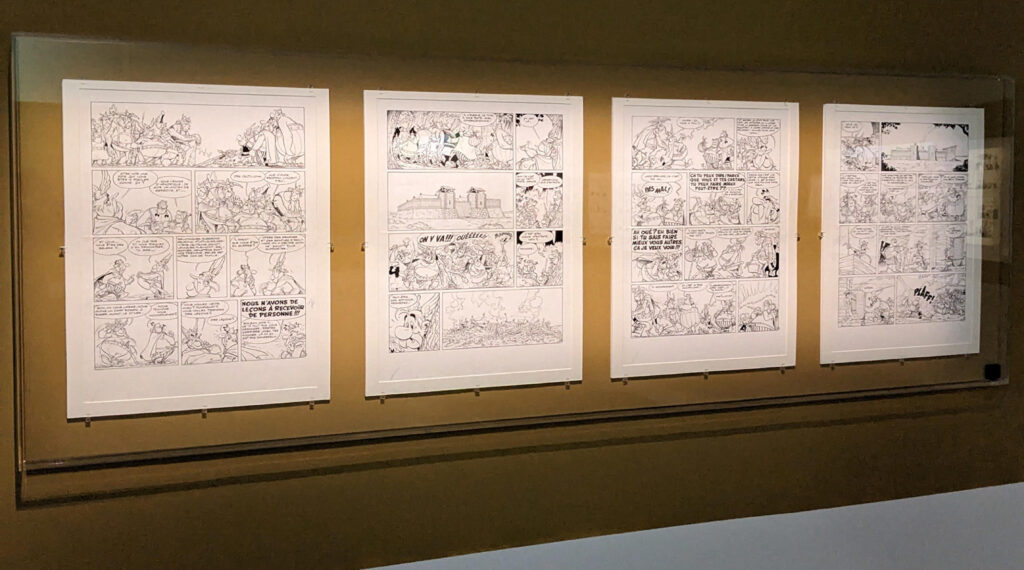
Humour awaits and as I leave Hall 1 for the second smaller space of hall 2, I turn upon four pages of Asterix in Belgium, by Albert Uderzo. It is so cleanly drawn, so beautiful, capturing all the actions that readers of the greatest Gaul would immediately recognise. I wonder if there will be a boar, or the inevitable flying Roman. With over 393 million Asterix books sold, translated into 111 languages, these original pages are a delight to consider.
The high calibre continues with four pages of Lucky Luke by Morris, three pages by Harvey Kurtzman, followed by Gotlib. The art has been hung beautifully, wired to the ceiling and the floor, giving a sense of space, with the art floating at eye level.
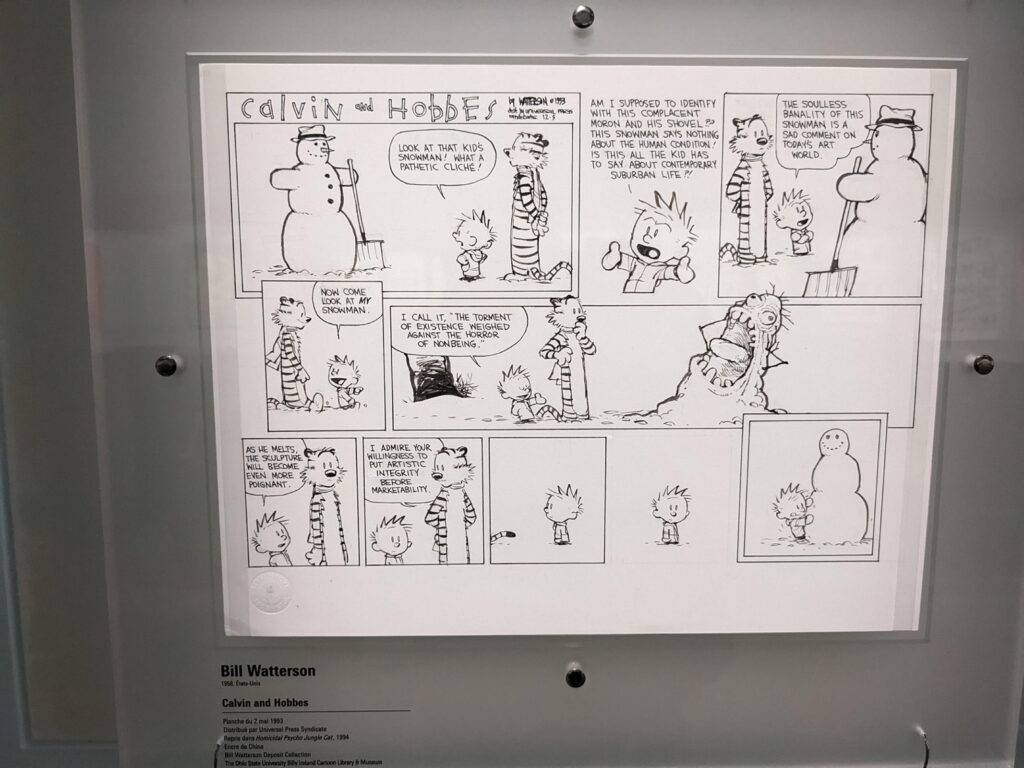
Next are two Calvin and Hobbes cartoons by Bill Watterson, on loan from the Ohio State University’s Billy Ireland Cartoon Library and Museum, art that is incredible to see up close, larger in its original form. In juxtaposition on the side of these two cartoons are two Snoopy pieces by Charles M Schulz, which are astounding. One is of Snoopy playing baseball and the other is of him in his Sopwith Camel, taking off and fighting against the Red Baron. Both are absolutely classic pieces to have here on view.
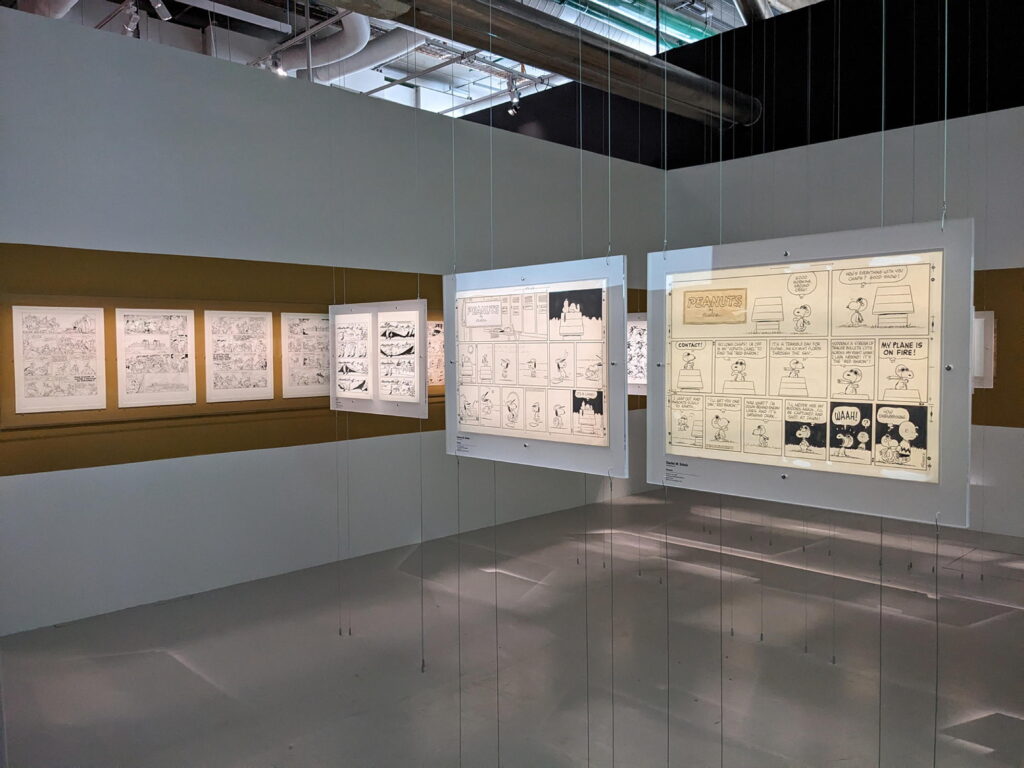
The smaller space has been utilised brilliantly and cleverly; there are over 50 pieces of art. At this point I am considerably overwhelmed, and I know it.
The whole floor is exciting; walls have projections, images, and film, colour fills the neutral spaces. As I move into the Fright section, the neutral walls are suddenly darkest black, and I am confronted by a full wall of Hideshi Hino art. I had thought I would keep track of how many pieces of art are on display, but I give up. I want to concentrate on the art, which is horrific and beautifully brilliant, reflecting his experience of growing up with the knowledge and shadow of the atomic bombings. His colour work is equally stunning.

I am taken with the wall of work by Anke Feuchtenberger. Later, Bernie Wrightson’s Frankenstein, or The Modern Prometheus, contrasts with a The Walking Dead image by Charlie Adlard and Tomb of Dracula by Gene Colan. Daniel Clowes’ colour work on Like a Velvet Glove Cast in Iron, Charles Burns’ El Borbah and Black Hole, and Emil Ferris’ Ghastly cover are just some of the stunning works in this section.
From the nightmares of Fright I walk into Dreams. The walls go from black to a deep blue, and I am taken by the work of Julie Doucet. There is enough on display to give the viewer a deep understanding and appreciation.
The next two sections flow quite beautifully. The Passage of Time and Personal Stories tell more intimate and thoughtful tales. I find that Jiro Taniguchi’s three pieces are nicely contrasted with Yu Takita’s three colour and three black and white pieces. The selection of Chris Ware art, none of which are small pieces to begin with, are both intimidating and impressive. It was quite amazing to see the original art for Building Stories, which I often feel is the successor of the well loved Acme Novelty Library. These, taken along with the rest of the exhibits, longer just communicate the fun of different formats, but create stories, constructing floors and windows into lives as we view the panels voyeuristically.
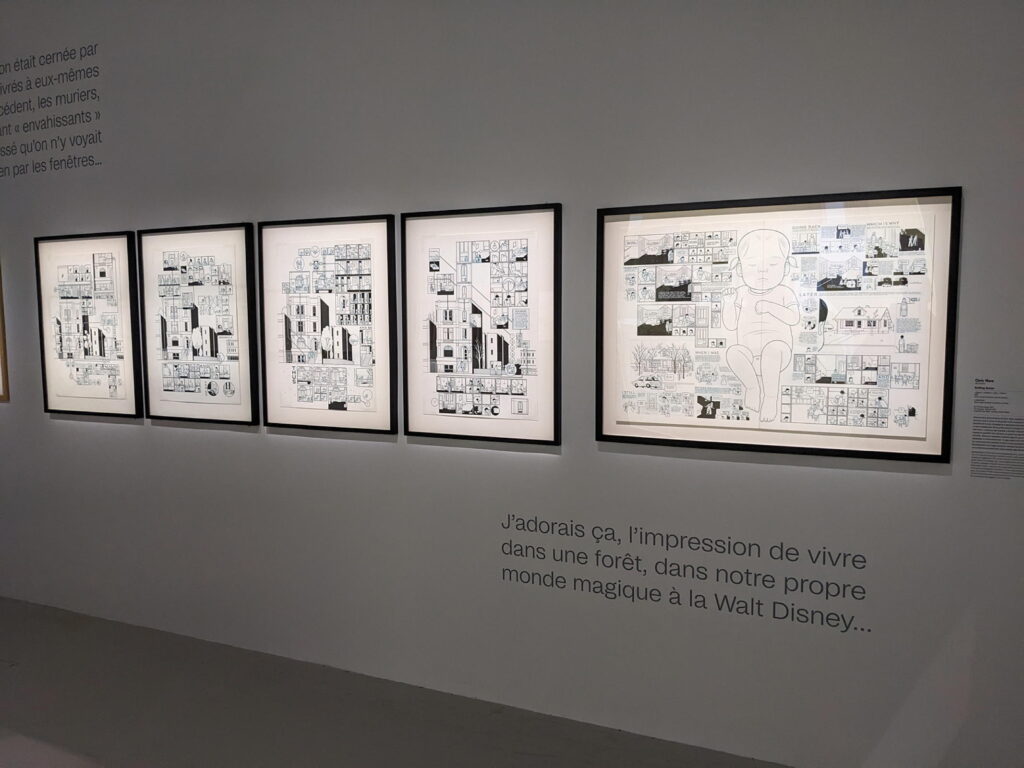
While the Chris Ware work was really amazing to see, it only accentuates the brilliance of other works in these sections, especially Anna Sommer’s work and Joanna Hellgren’s Frances. Andrè Juillard’s colour pieces draw one around to see the projection of art. It all works so smoothly, and this introduction to the work of the artists is balanced by the real effort to share the breath of work in every section. The variety of selections is sufficient to inspire appreciation and entice the viewer, but also leave one yearning to finish the stories that these beautiful pages come from.
The following section focuses on ‘Colour, Black and White’. The wall didactic mentions how, in 1975, Mœbius revived direct colour with his fantastical epic Arzach, which was followed by The Green Hand by Nicole Claveloux. Next, one is confronted by three pieces of Frank Miller art, huge splash pages from Sin City The Big Fat Kill, next to two pages of Mike Mignola art, Hellboy Seed of Destruction and Hellboy Storm and the Fury, the 12th volume in France.
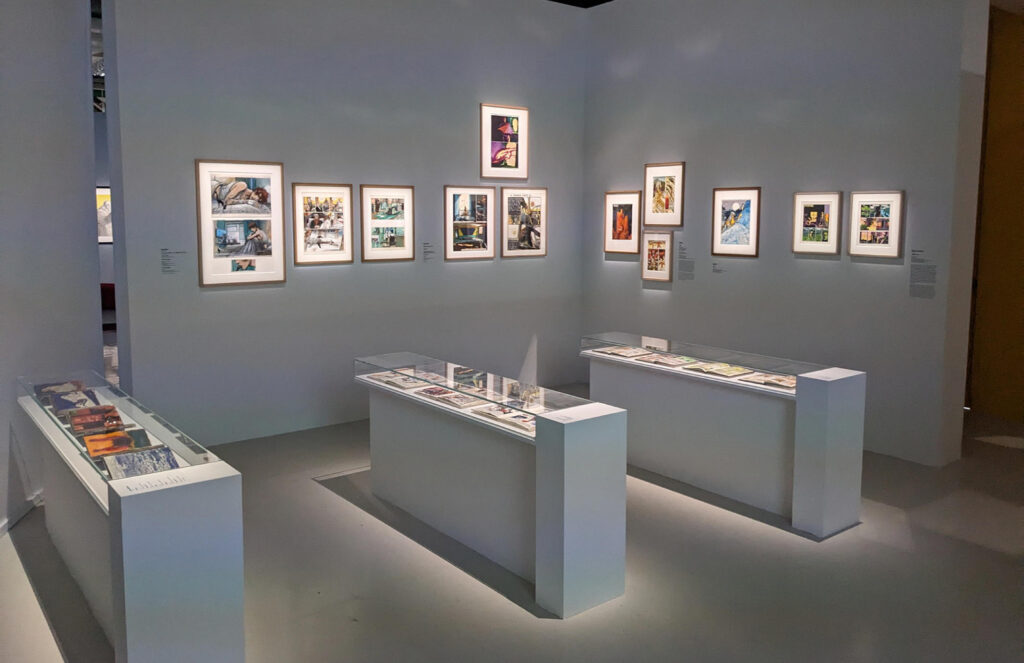
Three pages from Corto Maltese follow, which are absolutely stunning to see up close. The fine lines, action, excitement, and adventure is all captured here, and available to see up close and personal, inches away from where the hand of Hugo Pratt worked. Corto is a very thoughtful character, and while I’m accustomed to Pratt’s artwork being more paced, these are some beautiful pages to see, and are a hint of the incredible work elsewhere in the Centre Pompidou.
Next are three pieces by Mœbius, including the first page and plate of Arzach, which, the Centre notes “revolutionised the aesthetics and narrative pattern of science fiction comics”. Again, looking at the pieces up close is stunning.
There are so many sections, and I find I have encountered them out of order, but this is OK. I go into Personal Stories, where the focus is the autobiographical, and find three pieces by Alison Bechdel, Yoshihiro Tatsumi, and Dominique Goblet. The focus at this point is on Goblet’s Pretending is Lying, which took twelve years to create, and touches on her childhood memories, relationships (both with her father and romantic partners), and employs a mixture of media, pencils, collage and paint. It is wondrous to see Goblet’s work.
Then a pair of personal favourites: Marjane Satrapi’s Persepolis and Emmanuel Gilbert Alan‘s War. Gilbert’s work is the biography of World War Two GI Alan Cope, whose wonderful story of immigration to France after the War is both compassionate and reflective – certainly not the typical war story.
It is amazing to think the original four volumes of Persepolis are twenty years old now. It is a beautiful comic, tracing the author’s fascinating story beginning with the Iranian Islamist Revolution in 1979, her youth in Austria, then back to study in Iran, and ending life in Paris. Seeing both these works here, close to each other, surfaces an interesting commonality and creates space and time for thought.
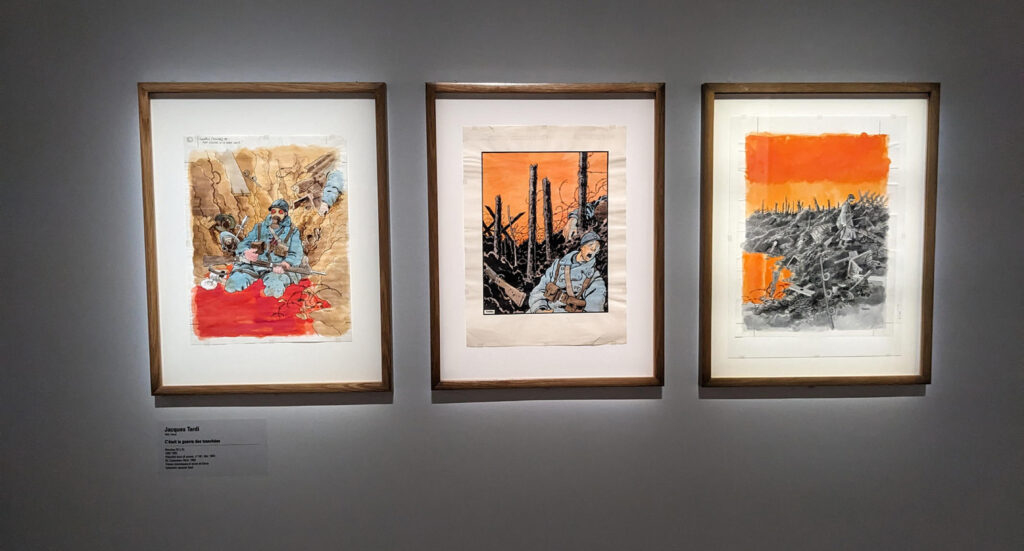
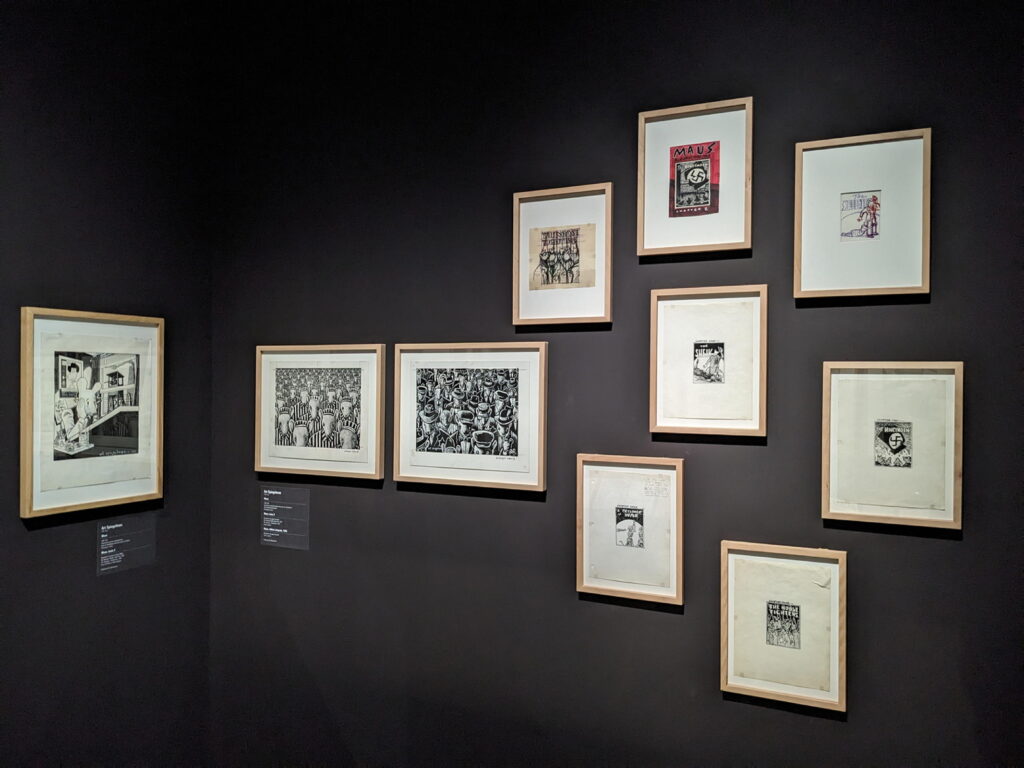
The works that stun me continue. I have lost track of where I am, engrossed as I am by the art, and soon I am faced with fifteen pieces by Jaques Tardi. I have moved into the History and Memory section, and I am surprised by the three colour pieces, and four black and white, from It was the War of the Trenches. I am surprised to find that I cannot recall these painted images, which confounds me, as they are so well done and the colour work is so clear, that I’m sure I would have remembered them. These are followed by four pages from I, Rene Tardi, Prisoner of War in Stalag IIB.
Then there is a series of eight pieces by Keiji Nakazawa. The standard is set; this must be the seminal work, “Barefoot Gen”, published in Weekly Shōnen Jump fifty years ago in Japan. It is a record of the atomic nightmare that befell Hiroshima, tinged by the personal tragedy that Nakazawa, who lost his Da, brother, and sister, also experienced.
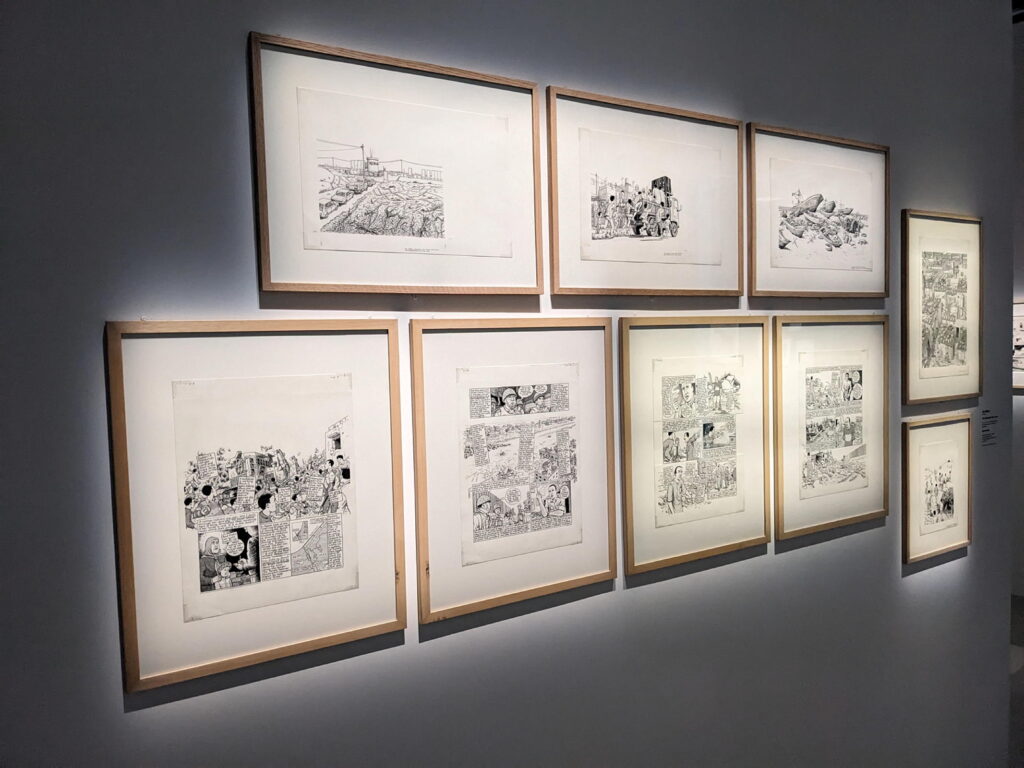
A selection of pieces by Joe Sacco is presented to remind readers of the continuing relevance of comics. I spend considerable time looking at these, which include images from the 2003 work The Underground War in Gaza, published in The New York Times Magazine, and Footnotes on Gaza. The portfolio, a total of nine images rich with skillfully-communicated journalistic information, are poignant given current ongoing events.
I hear a quiet voice and walk into a square space within this hall. The imagery is immediately recognisable: Art Spiegelman. The voice I hear must be Vladek Spiegelman. Indeed I discover that the Museum has a recording of over five minutes of him sharing his story as a survivor of Auschwitz. The art is incredible, Maus being one of the most important comics and again, here one considers how adeptly this exhibit has been presented: a distinct space, with a distinct, personal voice. This is certainly true of the Maus exhibit, with twenty seven pieces overall, offering such a breadth of original art in a unique space that creates a close, intimate experience with Vladek Spiegelman’s voice. Personal and strong, just like the comic, and very well done on the part of the curators.
This is followed by five huge Philippe Druillet pieces and a massive two-way screen with clips from Akira. These capture the eye and are a good example of the brilliance in planning ‘Comics on Every Floor’ in that they show how one is continually being drawn through the exhibition. Admittedly I went too fast, so I went back, and forward, back again, and realised that I was by that stage very alone, except for the staff, who seemed to just be barely present, subtly unobtrusive.
I have travelled through a beautiful section that was entitled Literature. The Centre has “teamed up with IRCAM (the Institute for Research and Coordination Acoustics / Music) and the composer Sébastien Gaxie to create Echoes of Words and Drawings, a sound version of boards from the works Of Mice and Men (John Steinbeck), Fog Over Tolbiac Bridge (Léo Malet), Pinocchio (Carlo Collodi) and Vernon Subutex (Virginie Despentes).” Posy Simmonds work on Gemma Bovery and Winshluss’s Pinochio are just some of the amazing works here.
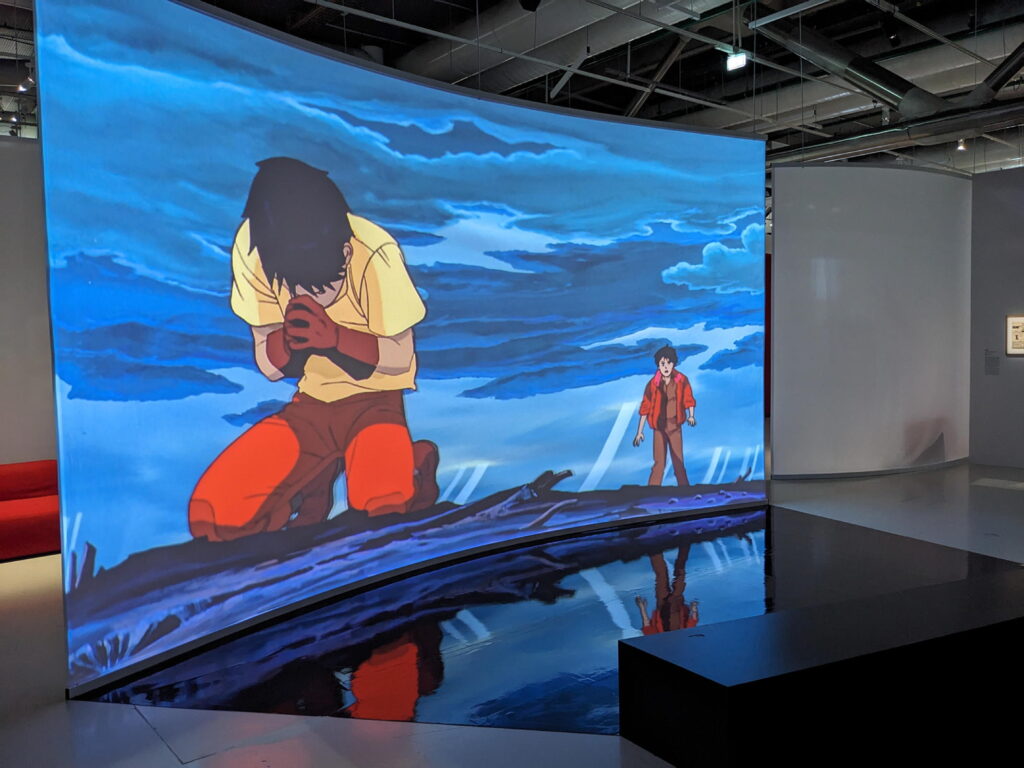
I watch Keneda and Tetsuo, characters from Akira, and and am drawn into the Future Fiction section. Here I am confronted by an amazing Frank Miller graphic novel cover for a Titan Books edition of The Dark Knight Returns, two pages of Watchmen drawn by Dave Gibbons, a Superman cover by Neal Adams, and then some Osamu Tezuka. As I turn around, I am presented with a selection of US comic book covers: Fantastic Four, Captain America, Silver Surfer, Daredevil, Sensational Spider-Man and Thor art by Gene Colan, Gil Kane, Jack Kirby, John Busema, and Marie Severin.
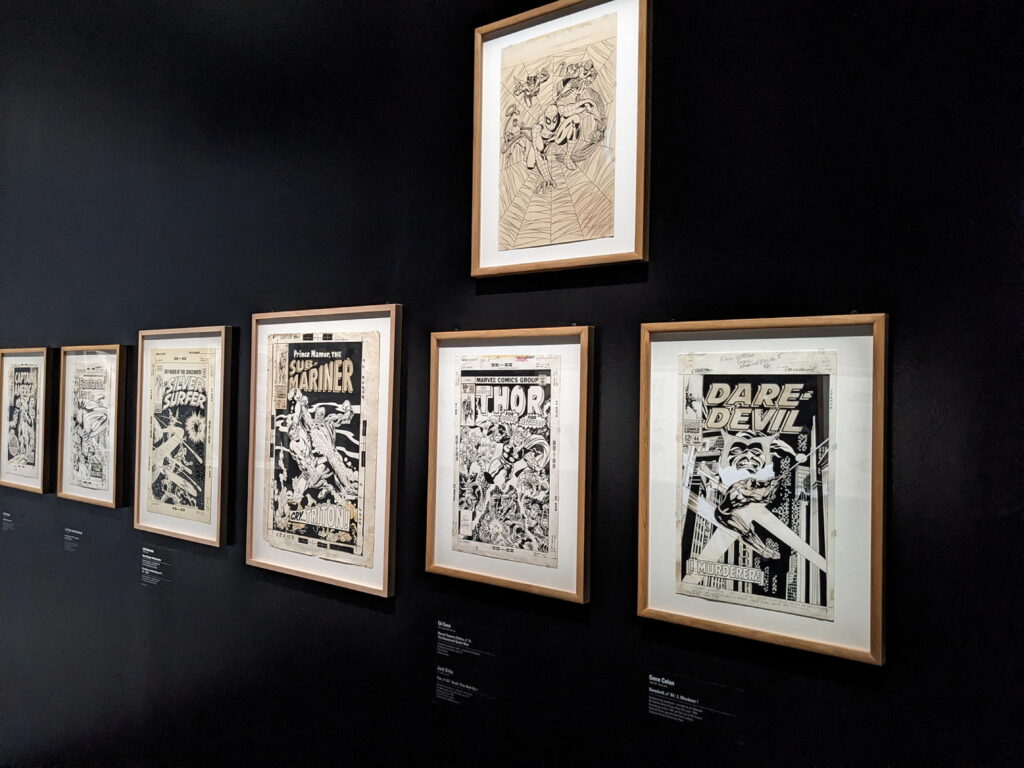
These incredible comic book pieces speak to the calibre of every wall, every section, every hall. They are of the most impeccable kind, stunning, and then as I walk around another corner, I am confronted by another grouping of works by Mœbius.
The Cities section has an incredible installation built by Seth. I am delighted to find work by François Schuiten and stunned to see a number of pages by Will Eisner. From here, full wall murals of work by Chris Ware make the geometric space filled with colour, brightness, and original work by Ware, Yuichi Yokoyama, and Jochen Gerner.

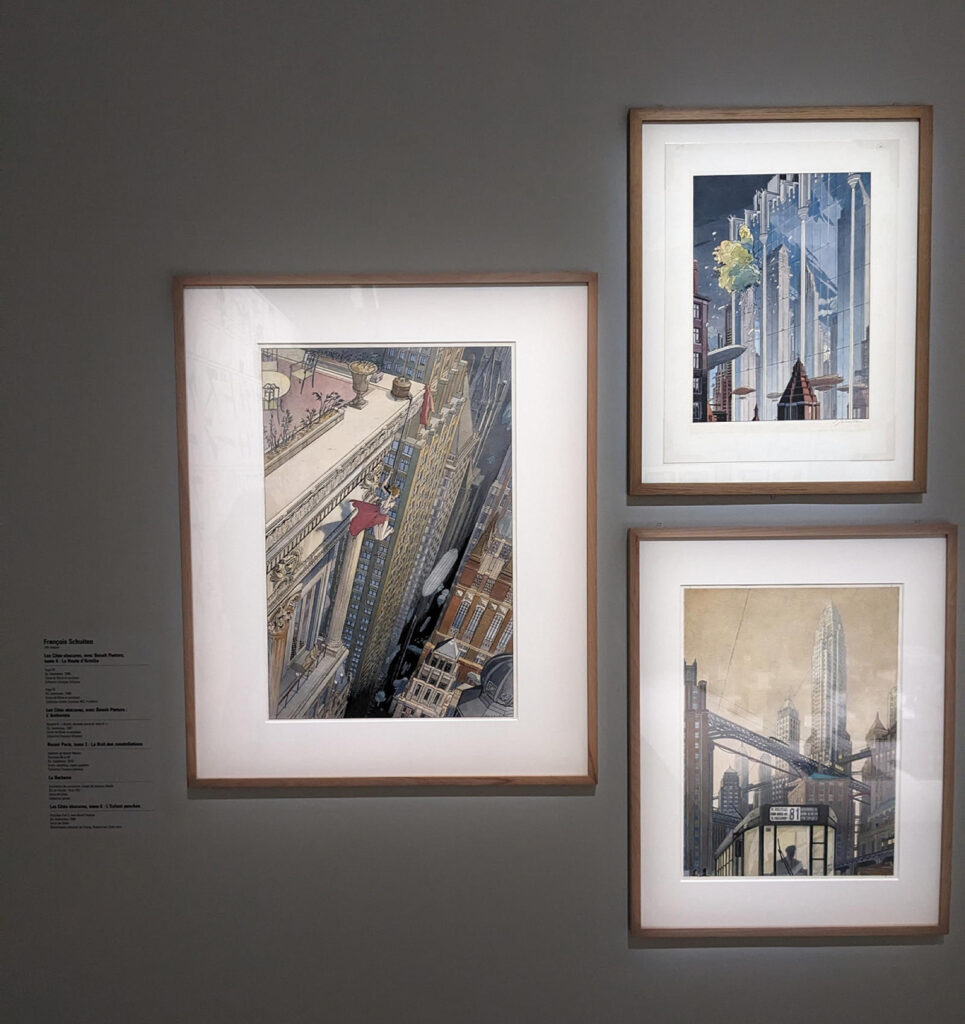

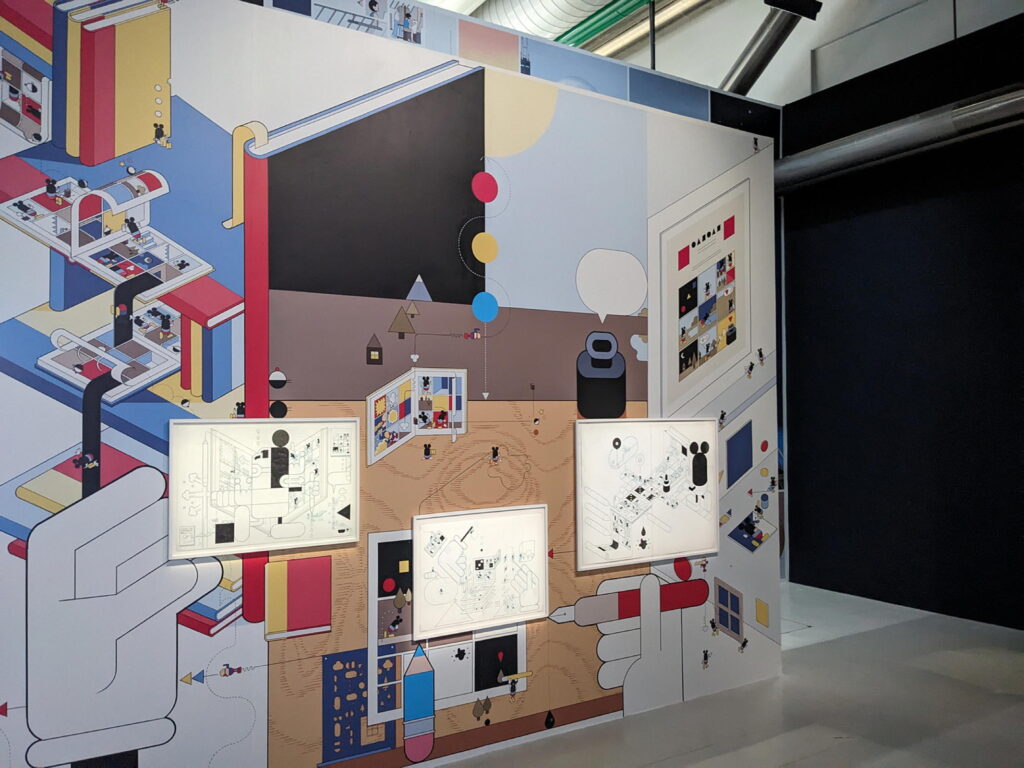
Comics 1964 – 2024 is a phenomenal exhibition, and yet this is just the first floor of what the Centre Pompidou has to offer comic readers and fans. I am walking on a mix of delight and intense overwhelmedness as I exit. The museum team quietly do likewise and close up the doors. I have taken much longer than I anticipated, and the exhibit, sorry, this exhibit, is but a single part of what the six floors of the “Comics On Every Floor” celebration has to offer. It has left me so impressed.
One has to ask if the standard has been equalled, in its breadth and depth and quality. How often have we had an exhibit where so many hundreds of pieces of original art are on display, with the whole exhibition space dynamically used to reflect comics, to portray comics, to highlight comics? The thoughtfulness of the layout, the groupings, the explanations of themes, the descriptions and detail of the creatives involved is all excellent, and creates an incredibly brilliant exhibition.
Our sincerest thanks to Centre Pompidou, the understanding staff and the assistant attaché de presse Antoine Martin Charlot for facilitating the visit.
James Bacon
• Comics 1964 – 2024 runs until 4th November 2024 at the Centre Pompidou, Paris
Our much appreciated Irish contributor and comic fan continued his tour of the Centre Pompidou and in the second part, coming soon, we’ll hear about the Corto Maltese exhibition and the other elements that the Centre Pompidou have brought together to create a massive comic book experience in “LA BD a tous les étages!”
FURTHER LISTENING…
As part of the audio tour of the Centre Pompidou’s milestone exhibition of works by 130 artists, twelve represented comics creators “…from different generations, …talk about their work and the major themes found along the tour.”
Links below are to one of the artist’s social media pages, web site or publisher page
1. Counterculture with Art Spiegelman
2. Laughter, with Catherine Meurisse
3. Fright with Emil Ferris
4. Dreams with Blutch
5. As Days Go By with Camille Jourdy
6. Personal Stories with Étienne Davodeau
7. Colour / black and white, with Lorenzo Mattotti
8. History and memory, with Emmanuel Guibert
9. Literature, with Posy Simmonds
10. Future Fiction, with Philippe Druillet
11. Cities with Nicolas de Crécy
12. Geometry with Jochen Gerner
Categories: Comics, downthetubes News, Events, Exhibitions, Features, Other Worlds, Reviews

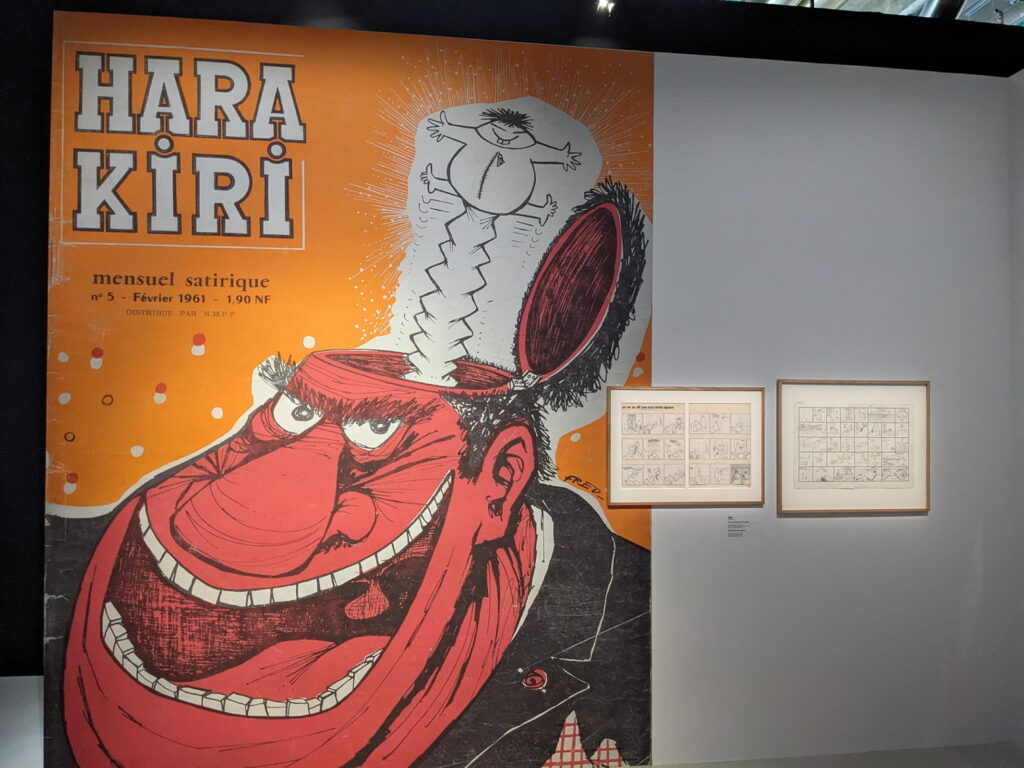
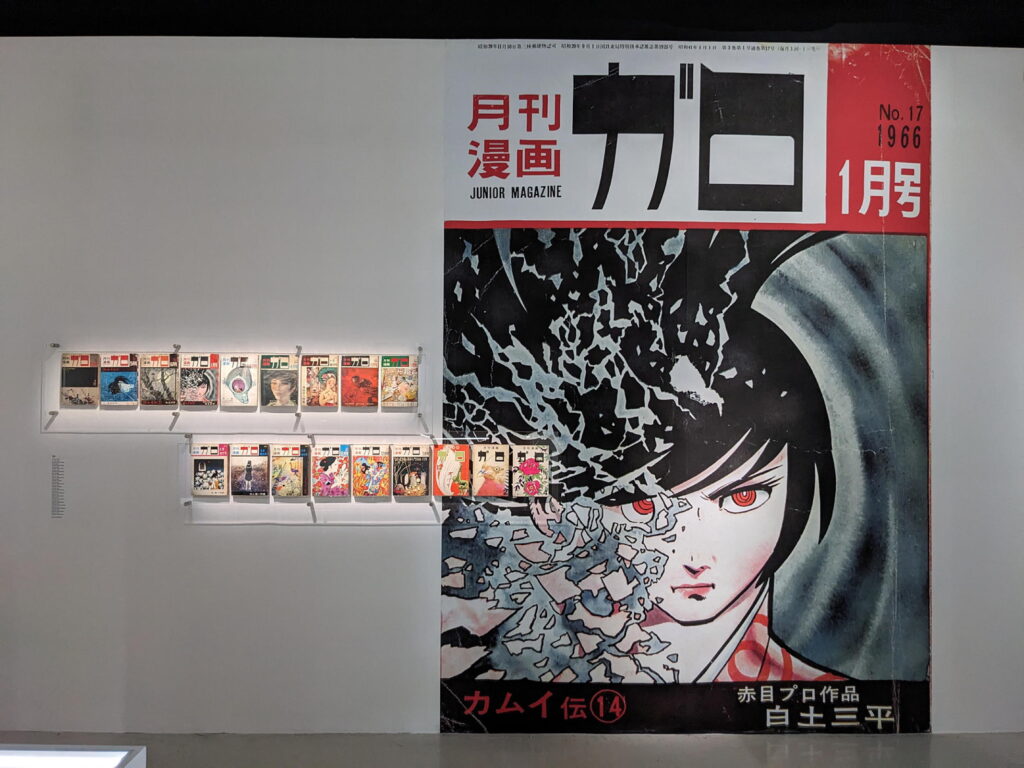

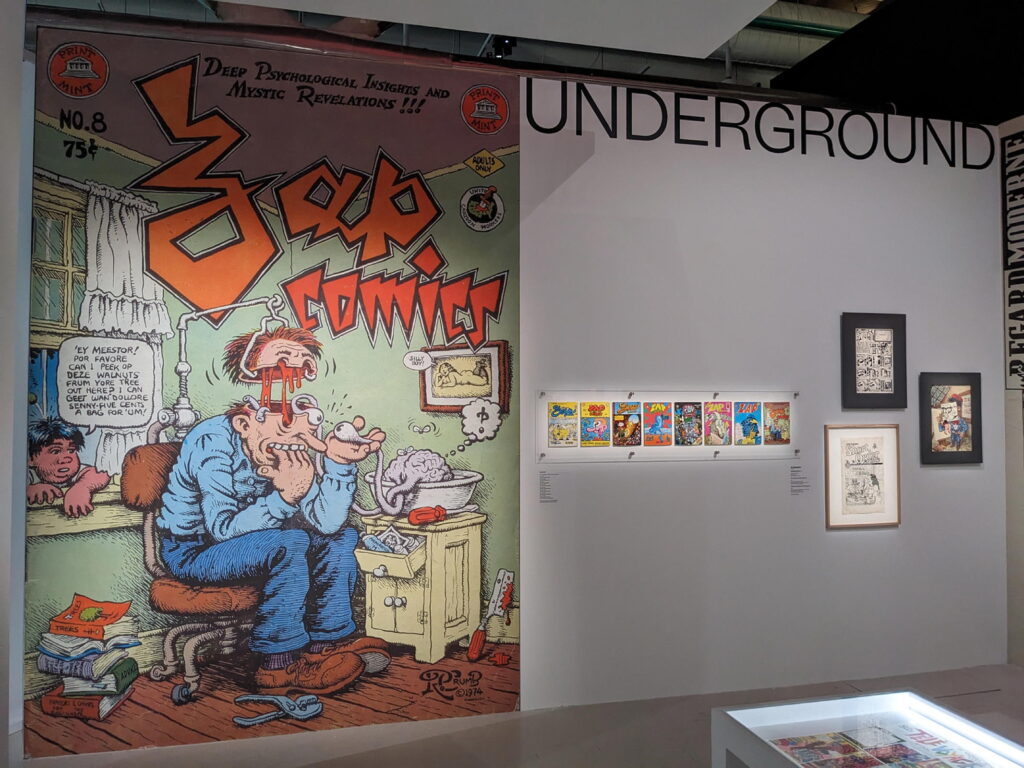
 Temenggong-SuperAni 2025, Celebrating 50 Years of Singapore -South Korea Bilateral Relations and Singapore’s 60th Anniversary
Temenggong-SuperAni 2025, Celebrating 50 Years of Singapore -South Korea Bilateral Relations and Singapore’s 60th Anniversary  In Review: Into Battle: The Art of British War Comics
In Review: Into Battle: The Art of British War Comics  Comics Abroad: A Visit to the Cartoon Art Museum, San Francisco
Comics Abroad: A Visit to the Cartoon Art Museum, San Francisco  In Review: The Steve Dillon Exhibition at Lawless
In Review: The Steve Dillon Exhibition at Lawless